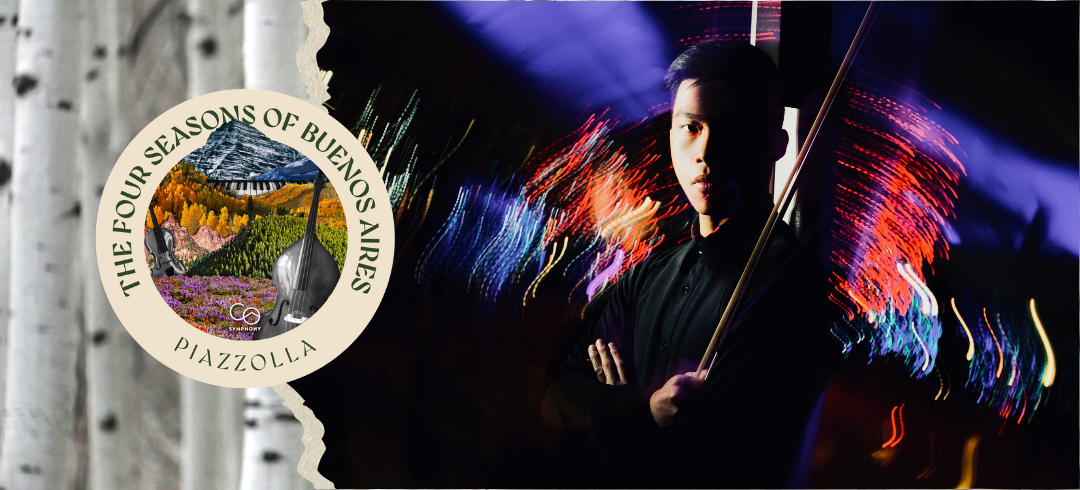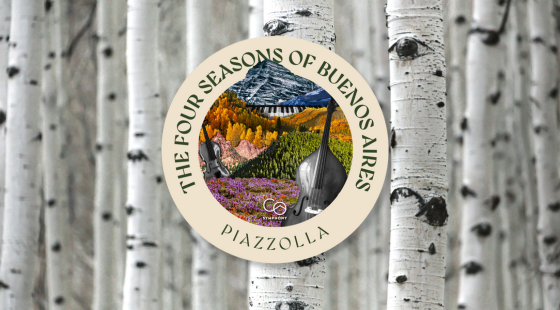When Antonio Vivaldi painted the year in music with The Four Seasons in 1725, he captured the shifting moods of nature with vivid detail: chirping birds in spring, violent storms in summer, icy winds in winter. More than two centuries later, in a very different corner of the world, Argentine composer Astor Piazzolla took up the idea with a new voice and new rhythms, reshaping it through the lens of tango and the soundscape of Buenos Aires. The result, Las Cuatro Estaciones Porteñas (The Four Seasons of Buenos Aires), has become one of Piazzolla’s most celebrated creations, a work the Colorado Symphony will perform November 21–23, 2025 at Boettcher Concert Hall.
Tango’s Journey from the Shadows
The tango has never been just a dance. Born in the late 19th century in the gritty docklands of Buenos Aires, it was forged from a cultural collision of African rhythms, Spanish flamenco fire, Cuban habanera sway, and the native Argentine milonga, with each contributing to its DNA. In its early days, the tango thrived in bawdy houses and back-alley bars, giving voice to longing, hardship, and broken dreams. By the 1920s, it had leapt across the Atlantic to Paris, where high society embraced it with the same fervor as they had once dismissed it. Soon, tango was everywhere, sweeping across Europe, entering ballrooms in America, and even inspiring composers like Stravinsky and Walton.
Piazzolla and the Birth of Nuevo Tango
Into this world stepped Astor Piazzolla (1921–1992), a bandoneón virtuoso who grew up in New York before returning to Argentina to make his mark. Trained in classical composition by Alberto Ginastera and later in Paris by Nadia Boulanger, Piazzolla fused tango with jazz harmonies, counterpoint, and contemporary classical techniques. He called this new style Nuevo Tango, a daring reinvention that outraged purists but captivated younger audiences hungry for something fresh.
By the 1970s, Piazzolla was internationally recognized as the man who revitalized tango, dragging it from smoky dance halls into concert halls without losing its soul. His music, at once fiery and melancholy, has since become a staple for both tango ensembles and symphony orchestras alike.
“Traditional tango listeners hated me. All the tango critics and radio stations of Buenos Aires called me a clown. And they made me popular.”
Astor Piazzolla, composer
The Four Seasons of Buenos Aires
Composed originally between 1965 and 1970, Piazzolla’s Four Seasons were first written as stand-alone pieces for piano and later arranged for his own quintet. They eventually became a cohesive set for strings, full of sharp rhythms, lush harmonies, and sly nods to Vivaldi’s masterpiece.
Unlike Vivaldi’s baroque tone-painting, Piazzolla’s Seasons are less about literal scenes and more about the city’s atmosphere: Buenos Aires in bloom or in heat, restless in autumn or brooding in winter. At times, you hear the bustling streets, the swirl of tango dancers, or the melancholy of a solitary bandoneón. It’s music of passion and grit, equally at home in a dance club or on the concert stage.
A Symphony of Worlds Colliding
Hearing The Four Seasons of Buenos Aires with full orchestra is to experience tango on a grand scale: the intimacy of its origins stretched across symphonic forces, its rhythms both sensual and explosive. For audiences at Boettcher Concert Hall this November, it’s a chance to feel the heartbeat of Buenos Aires, reimagined by a composer who defied tradition and transformed a national dance into a universal art form.
Hear The Four Seasons of Buenos Aires Live
Join your Colorado Symphony and Music Director Peter Oundjian this November for a stunning performance of Piazzolla’s The Four Seasons of Buenos Aires featuring guest violinist Kerson Leong.


